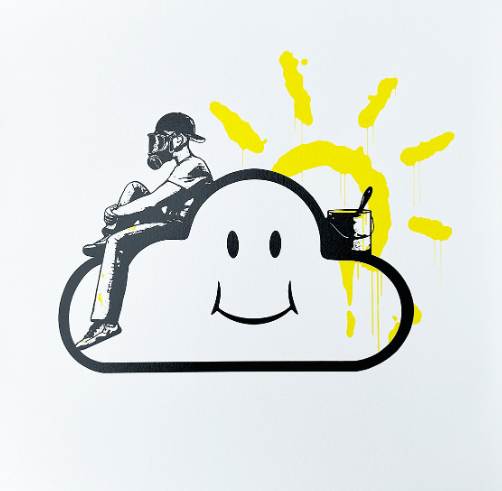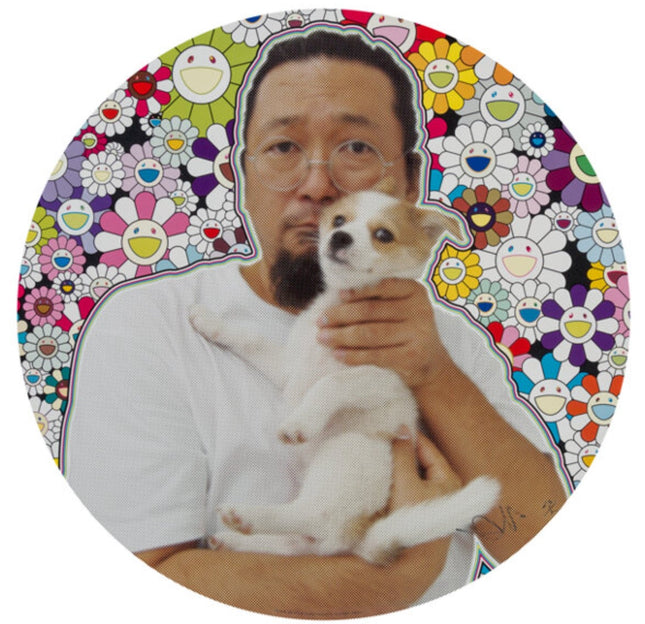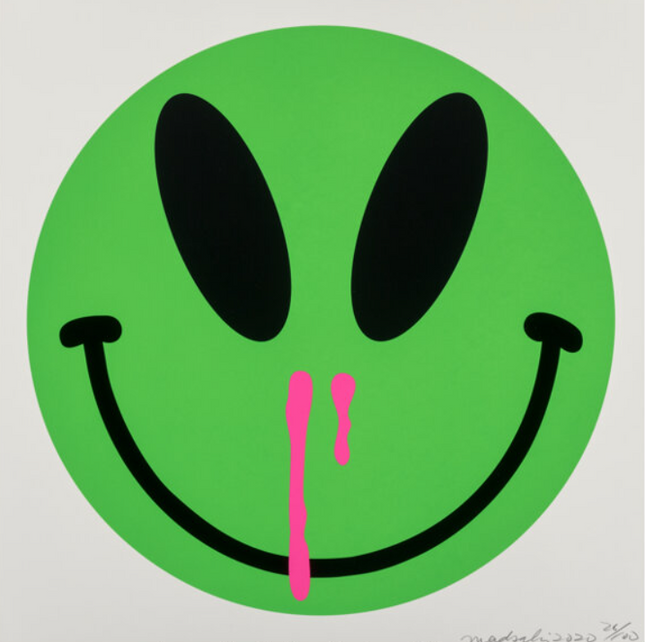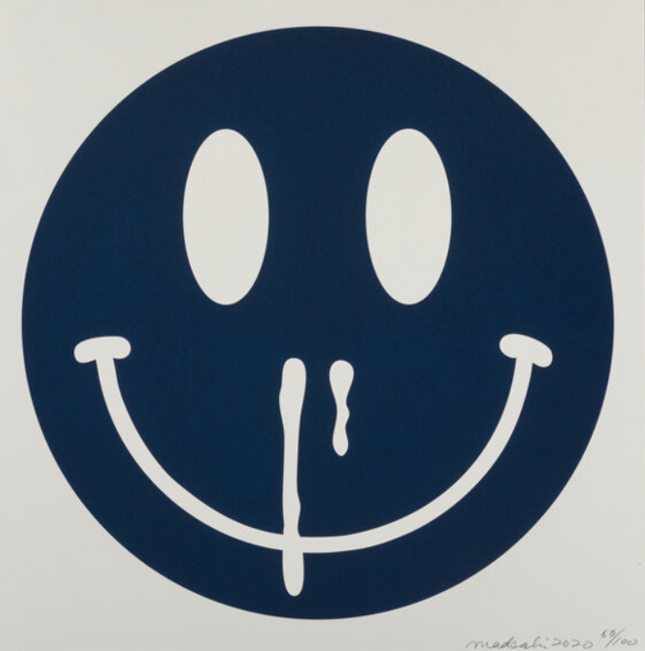
Smile
-

Takashi Murakami TM/KK POM & Me Lithograph Print by Takashi Murakami TM/KK
POM & Me Offset Lithograph Print Limited Edition Artwork on Round Smooth Wove Paper by Pop Urban Artist Takashi Murakami TM/KK. 2013 Signed & Numbered Limited Edition of 300 Round Cut Artwork Size 19.75x19.75 (Round) Takashi Murakami (b. 1962) POM & Me, 2013 Offset lithograph in colors on smooth wove paper 19-5/8 inches (49.8 cm) diameter (sheet) Ed. 300 Signed and numbered in ink lower right Published by Kaikai Kiki Co. Ltd., Tokyo "POM & Me" is a lithograph print by the renowned Japanese artist Takashi Murakami. Known for his unique style that blends traditional Japanese art with contemporary pop culture, Murakami has gained international acclaim for his work. His signature "Superflat" style is characterized by bold, vibrant colors and flattened, two-dimensional imagery. The "POM & Me" print is one of many artworks that Murakami has created over the years, often featuring his iconic characters and motifs. This particular piece includes recurring elements from Murakami's body of work, such as his famous flowers, himself and his dog Pom. As an artist, Murakami has worked in various media, from painting and sculpture to fashion and commercial products. His work has been exhibited in major galleries and museums worldwide, and he has collaborated with well-known brands and celebrities.
$2,368.00
-

Madsaki Cosmic Overdose_P Offset Lithograph Print by Madsaki
Happiness Overdose Azul Mariano_P Offset Lithograph Print by Madsaki Print on Wove Fine Art Paper Limited Edition Hand-Pulled Street Pop Artwork Graffiti. 2020 Signed & Numbered Limited Edition of 100 Offset Lithograph Artwork Print Size 19.75x19.75 Smiley Face With Bloody Nose in Blue. Kaikai Kiki Co. Ltd, Tokyo. Unconventional Aesthetics of Madsaki's Artwork Madsaki's artwork, characterized by its distinctive use of color and form, critiques modern society's obsession with happiness and the often ironic underpinnings of this pursuit. The "Happiness Overdose Azul Mariano_P" print showcases a smiley face—a universally recognized symbol of joy—juxtaposed with a bloody nose, suggesting an overdose of happiness to the point of harm. This striking imagery, rendered in bold blue on fine art paper, invites viewers to question the true nature of joy and the cost of its excess. The resurgence of pop art in the contemporary art scene is epitomized by the creative convergence of street art and graffiti, with artists like Madsaki at the forefront. "Happiness Overdose Azul Mariano_P," a limited edition offset lithograph print by Madsaki, exemplifies this trend, blending the rebellious spirit of street art with the vibrant aesthetics of pop art. Madsaki's artwork, characterized by its distinctive use of color and form, critiques modern society's obsession with happiness and the often ironic underpinnings of this pursuit. The "Happiness Overdose Azul Mariano_P" print showcases a smiley face—a universally recognized symbol of joy—juxtaposed with a bloody nose, suggesting an overdose of happiness to the point of harm. This striking imagery, rendered in bold blue on fine art paper, invites viewers to question the true nature of joy and the cost of its excess. The Cultural Significance of Offset Lithograph Prints Offset lithography, a common technique for fine art reproduction, allows artists like Madsaki to reach a wider audience by creating multiple copies of original works. This print's size of 19.75x19.75 inches is substantial yet accessible, fitting the urban environments that often inspire street pop art. Hand-pulling each print ensures that every piece retains a touch of the artist's hand despite being part of a limited edition series. The choice of woven fine art paper as the medium further signifies a blend of street art's immediacy and fine art's enduring quality. In the context of street pop culture, limited edition artworks such as "Happiness Overdose Azul Mariano_P" reflect the exclusivity and collectibility that street art has gained in the art market. The limited edition of 100 pieces, each signed and numbered by Madsaki, speaks to the artist's personalized connection with his work and collectors. It represents a shift from the transient nature of traditional graffiti to a more permanent, revered form of artistic expression. Integration of Street Art into Mainstream Art Galleries Madsaki's collaboration with Kaikai Kiki Co. Ltd, Tokyo, a company known for its role in promoting contemporary artists, underscores the increasing integration of street pop art into mainstream art galleries and the broader art world. This partnership illustrates the potential for street-inspired artworks to be celebrated alongside more traditional acceptable art forms, signaling a shift in cultural perceptions and the breaking down of barriers between high art and popular culture. The impact of "Happiness Overdose Azul Mariano_P" extends beyond its visual composition; it encapsulates the evolution of street art into a form that is both a critical commentary on society and a coveted acceptable art commodity. Through his work, Madsaki challenges viewers to reassess their understanding of happiness, consumerism, and the role of art in modern culture. His street pop art & graffiti artwork continue to resonate with audiences around the globe, bridging the gap between underground art movements and the polished white walls of galleries.
$2,188.00
-

Madsaki Happiness Overdose Azul Mariano_P Offset Lithograph Print by Madsaki
Happiness Overdose Azul Mariano_P Offset Lithograph Print by Madsaki Print on Wove Fine Art Paper Limited Edition Hand-Pulled Street Pop Artwork Graffiti. 2020 Signed & Numbered Limited Edition of 100 Offset Lithograph Artwork Print Size 19.75x19.75 Smiley Face With Bloody Nose in Blue. Kaikai Kiki Co. Ltd, Tokyo. Blending Iconography with Contemporary Critique "Happiness Overdose Azul Mariano_P" is a captivating example of Madsaki's work, exemplifying the essence of Street Pop Art and graffiti Artwork through its graphic simplicity and poignant symbolism. This 2020 offset lithograph print on wove fine art paper, signed and numbered as a limited edition of only 100, showcases a unique blend of street art's rawness with the mass appeal of pop art. The artwork, measuring 19.75x19.75 inches, presents a stylized smiley face with a blue hue and a notable addition: a bloody nose. This visual twist plays with the universally recognized symbol of happiness, the smiley face, subverting it to convey a more profound, more complex message. Madsaki's choice to depict the smiley with a bloody nose might be interpreted as a commentary on the excesses of contemporary society, where the pursuit of happiness can sometimes lead to self-destructive behaviors. The use of a singular bold color, Azul Mariano, lends the piece a striking visual presence, with the blue acting as both a backdrop and a critical element of the artwork. The color choice may invoke various emotional responses, from calmness to melancholy, further enriching the artwork's interpretive layers. Artistic Expression in Street Pop Art & Graffiti Artwork Madsaki's "Happiness Overdose Azul Mariano_P" is a testament to the power of Street Pop Art and graffiti Artwork to communicate complex ideas through seemingly simple imagery. The expressive capacity of the work is amplified by its minimalist approach, where the absence of intricate details forces the viewer to confront the unsettling juxtaposition of the smiley's cheerful connotations with the graphic indication of distress. As with much of Street Pop Art and graffiti Artwork, there's an inherent accessibility in Madsaki's lithograph. The smiley face, a pervasive icon of modern digital communication, becomes a canvas for social commentary, allowing the artwork to resonate with a diverse audience. The limited-edition nature of "Happiness Overdose Azul Mariano_P" elevates it from a piece of street art to a sought-after collectible, bridging the gap between graffiti's ephemeral nature and fine art's permanence. In conclusion, the piece serves as a work of art and a cultural critique, encapsulating the dualities in pursuing happiness in the modern age. The choice to produce a limited run of prints ensures that each piece remains a unique and valuable addition to contemporary art discourse. Madsaki's "Happiness Overdose Azul Mariano_P" stands as a compelling intersection of pop iconography and street art sensibility, a visual exploration of the highs and lows of the human condition.
$2,188.00




